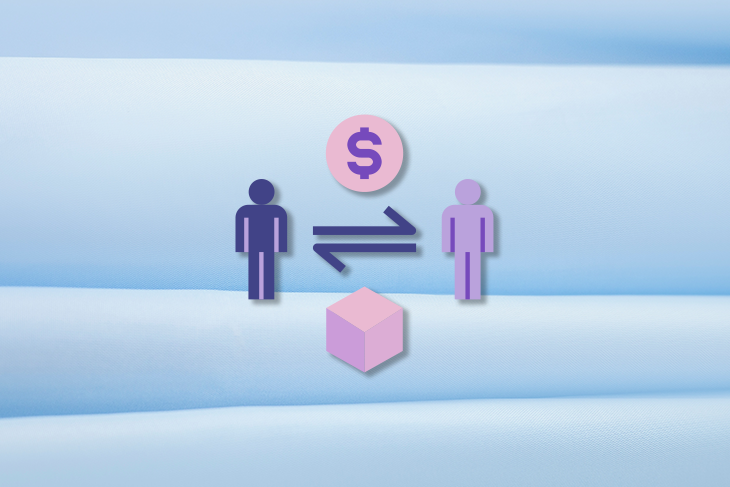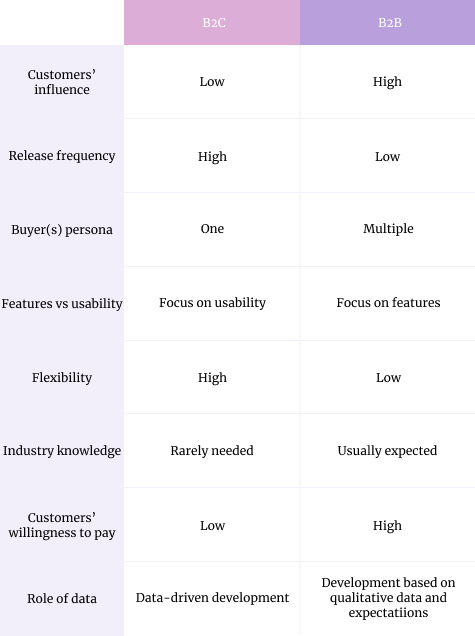Product management is a broad discipline. It can include everything from strategic work, to discovery, to execution, to marketing, and even more.

Given the breadth of the role, it’s impossible to master everything. There are just too many possibilities. That’s why we have various specializations, such as core product managers, growth product managers, platform PMs, etc.
Even within these layers of specialization, there is a distinction between product managers who manage B2C vs. B2B products.
Serving a mass customer or an enterprise makes an enormous difference in both the way the product is built and the role of a product manager.
On the one hand, the basic principles of product management remain the same: it’s all about achieving business outcomes by solving user problems. However, the details of how to do that daily differ significantly.
The biggest differences lie in:
Let’s explore each area in detail.
One of the most notable differences between B2B and B2C segments is the amount of influence a single customer might have.
It’s quite common for B2B products to encounter situations such as one big customer needing a special feature. The truth is, if the customer accounts for, say, 30 percent of your revenue, it’s very hard to say no to such a request — even harder if they are willing to sponsor it.
In the case of B2C product management, though, a single customer usually drives no more than 0.1 percent of total revenue. I have yet to hear about a B2C product making adjustments for a single customer.
Most consumer products have a higher release cadence than business products.
For B2C products, the market is usually very competitive; speed is everything. Moreover, users quickly get bored with new products, so a constant stream of fresh content is critical.
While frequent updates might sometimes be annoying, end-users often don’t even notice them.
It’s an entirely different story for B2B customers. Changing how things work usually results in temporary productivity dips as users have to update the product and get used to new things. Frequent drops in productivity could make a significant impact on the company’s bottom line.
More significant updates often require companies to update their product manual, training programs, etc. It’s a way bigger hassle than just pressing the “update now” button. Getting an update every week is an enterprise customer’s dream.
That difference in release frequency requires more careful and considerate release planning for B2B products.
There’s a big difference between the buying process of B2C and B2B customers.
For consumer products, it’s pretty straightforward: more often than not, your user is your buyer. In some cases, you might have a separate buyer and user (e.g., a parent being a buyer and a child being a user), but it still shouldn’t complicate matters too much.
The story is utterly different for enterprise customers. The user is rarely a buyer and there are multiple decision-makers in the purchasing process. You often have to satisfy various people with competing priorities, such as:
The need to cater to multiple buyer personas makes B2B product development and prioritization more complex.
While B2C users often require a polished, smooth experience, a B2B user just wants as many of their jobs to be done as possible.
An ideal B2C product seamlessly blends into users’ lives. The products that stick are those that integrate into our day-to-day lifestyle. If using a product generates additional friction, it’s often frustrating and might influence consumers to drop the product or switch to an alternative.
In this way, B2B customers care more about features that help to get the job done. Even if a product has subpar UX, it’s still a viable solution as long as it helps get done what needs to be done.
Plus, B2B users often use the product for hours a day, whether they want to or not. Over time, they’re more likely to get used to usability issues and even stop noticing them altogether.
 Jira is a perfect example. There is enormous hate for this tool in the industry. Although it has some serious usability issues, there’s barely any competition for it — it just has hundreds of features that are applicable in a wide range of scenarios.
Jira is a perfect example. There is enormous hate for this tool in the industry. Although it has some serious usability issues, there’s barely any competition for it — it just has hundreds of features that are applicable in a wide range of scenarios.
If you need something to be done in Jira, there’s a 99 percent chance you will be able to do so. The sheer volume of possibilities makes up for the poor user experience.
I can’t imagine life without Jira, even though it lags every five minutes. Talk about Stockholm Syndrome…
For B2C products, overall UX and usability are must-haves. For B2B products, functionalities and helping to get multiple jobs done is more important.
B2C products allow for more flexibility — or, as some say, agility — than their B2B counterparts.
One reason is the need for predictability in the case of B2B products. Enterprises usually need to know upfront what changes will be implemented in the product because their own plans might depend on it.
For this reason, B2B product managers often maintain an external roadmap for all current and potential customers. It forces them to plan a few months ahead and leave a little room for rapid pivots. Enterprise customers don’t like surprises.
In B2C, you have more wiggle room. You usually don’t have a public roadmap. And although your customers might have some expectations, they are rarely game-changing ones.
I’ve seen B2C products deprecate features overnight. Their B2B counterparts would have to announce it months in advance for their customers to prepare.
There’s a higher need for industry expertise in the case of B2B products vs. B2C products.
B2C products tend to have a broader, more general value proposition. Even if the product targets a niche persona, it’s still easier to empathize with an end user or try to wear their shoes.
B2B products are usually specialized solutions. If you are building, say, a tool for enterprise accountants, it’ll be tough to empathize with them if you don’t know what a balance sheet is. You can’t even play with the product yourself if you don’t know any accounting basics.
Given how niche most B2B products are, industry expertise is usually more than welcome, and basic industry knowledge is a must-have. B2C products are more accessible for generalists; it’s easier to understand the product without prior experience.
Enterprise customers are used to paying for services. Mass consumers love freebies. This difference dramatically impacts the whole prioritization and product creation process.
When building a B2B product, it’s all about return on investment. The price is a secondary factor as long as you can prove and pitch that the product will yield an overall positive ROI.
For example, if a product can help me save time equal to $50K every month, then even a cost as high as $40K for a monthly subscription seems somewhat justifiable — especially if there are no cheaper alternatives.
For B2C customers, it’s not so scientific. Consumers tend to purchase more on an emotional basis than based on coldhearted cost-benefit calculations.
Also, given how used we are to free products, every additional dollar on the price tag increases the friction dramatically, even if it’s justified. It’s not about deducing how much value given features deliver, but rather how much value the end-user perceives from these features.
Branding and messaging also play a critical role. It’s more an art than science.
In short, B2B products are more about cold calculations between costs and revenue. For B2C products, it’s more about the product’s overall branding, feel, and perceived value.
One of the best parts of being a B2C product manager is the number of data points you get.
With thousands, if not millions or even billions of users, you have an ocean of data you can analyze and gain insight from. You even have a chance to attract enough users to be able to run dozens of A/B tests single day. That’s true data-driven development.
Don’t get me wrong; you can still be data-driven with B2B. It’s just more challenging and less efficient. The data you get is usually less accurate and there is less room to run A/B tests. Not only might you not have enough users, but the need for long-term predictability reduces the usability of split tests.
Conversely, while B2C products’ roadmaps are often heavily dependent on quantitative data, B2B products tend to lean more on qualitative data and customers’ expectations.
The differences between B2C and B2B product managers are more varied and significant than you might imagine. To summarize the differences we highlighted in this post:

B2C product management is more about quick and dirty experimenting and pivoting. Product managers tend to be generalists, and the product management process is more flexible and data-driven. Empathy, data, and user experience are imperative here.
B2B product management is more like a strategic game of chess. Product managers are often subject matter experts and focus more on managing buyers and key players. It’s all about ROI calculations and proper expectations management.
Featured image source: IconScout

LogRocket identifies friction points in the user experience so you can make informed decisions about product and design changes that must happen to hit your goals.
With LogRocket, you can understand the scope of the issues affecting your product and prioritize the changes that need to be made. LogRocket simplifies workflows by allowing Engineering, Product, UX, and Design teams to work from the same data as you, eliminating any confusion about what needs to be done.
Get your teams on the same page — try LogRocket today.

A practical framework for PMs to use AI in ideation without sacrificing judgment, strategy, or decision quality.

A practical five minute revenue estimation method to help product managers compare ideas, drop low impact features, and prioritize smarter.

A practical guide for PMs who want to stop being bottlenecks, delegate smarter, and lead teams effectively with a clear ownership framework.

Stop letting unreliable data block features. Treat data as inventory to track quality, ownership, and ship with confidence.
One Reply to "B2B vs. B2C product management: Key differences and examples"
I think B2B product management is much easier than B2C